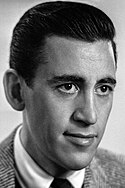J.D. Salinger Quote
Answer Professor Mandell’s letter when you get a chance and the patience. Ask him not to send me any more poetry books. I already have enough for 1 year anyway. I am quite sick of it anyway. A man walks along the beach and unfortunately gets hit in the head by a cocoanut. His head unfortunately cracks open in two halves. Then his wife comes along the beach singing a song and sees the 2 halves and recognizes them and cries heart breakingly. That is exactly where I am tired of poetry. Supposing the lady just picks up the 2 halves and shouts into them very angrily Stop that! Do not mention this when you answer his letter, however. It is quite controversial and Mrs. Mandell is a poet besides.
J.D. Salinger
Answer Professor Mandell’s letter when you get a chance and the patience. Ask him not to send me any more poetry books. I already have enough for 1 year anyway. I am quite sick of it anyway. A man walks along the beach and unfortunately gets hit in the head by a cocoanut. His head unfortunately cracks open in two halves. Then his wife comes along the beach singing a song and sees the 2 halves and recognizes them and cries heart breakingly. That is exactly where I am tired of poetry. Supposing the lady just picks up the 2 halves and shouts into them very angrily Stop that! Do not mention this when you answer his letter, however. It is quite controversial and Mrs. Mandell is a poet besides.
Related Quotes
I was just four when a hired teenage field hand attempted to molest me. Miraculously, I got away, and I told my dad. My father made three important choices that day: He listened to me, he believed me,...
Carolyn Byers Ruch
Tags:
awareness, believed, childhood, childhood sexual abuse, children, choices, encouragement, father, kids, listen
About J.D. Salinger
Jerome David Salinger ( SAL-in-jər; January 1, 1919 – January 27, 2010) was an American author best known for his 1951 novel The Catcher in the Rye. Salinger published several short stories in Story magazine in 1940, before serving in World War II. In 1948, his critically acclaimed story "A Perfect Day for Bananafish" appeared in The New Yorker, which published much of his later work.
The Catcher in the Rye (1951) was an immediate popular success; Salinger's depiction of adolescent alienation and loss of innocence was influential, especially among adolescent readers. The novel was widely read and controversial, and its success led to public attention and scrutiny. Salinger became reclusive, publishing less frequently. He followed Catcher with a short story collection, Nine Stories (1953); Franny and Zooey (1961), a volume containing a novella and a short story; and a volume containing two novellas, Raise High the Roof Beam, Carpenters and Seymour: An Introduction (1963). Salinger's last published work, the novella Hapworth 16, 1924, appeared in The New Yorker on June 19, 1965.
Afterward, Salinger struggled with unwanted attention, including a legal battle in the 1980s with biographer Ian Hamilton and the release in the late 1990s of memoirs written by two people close to him: Joyce Maynard, an ex-lover; and his daughter, Margaret Salinger.
The Catcher in the Rye (1951) was an immediate popular success; Salinger's depiction of adolescent alienation and loss of innocence was influential, especially among adolescent readers. The novel was widely read and controversial, and its success led to public attention and scrutiny. Salinger became reclusive, publishing less frequently. He followed Catcher with a short story collection, Nine Stories (1953); Franny and Zooey (1961), a volume containing a novella and a short story; and a volume containing two novellas, Raise High the Roof Beam, Carpenters and Seymour: An Introduction (1963). Salinger's last published work, the novella Hapworth 16, 1924, appeared in The New Yorker on June 19, 1965.
Afterward, Salinger struggled with unwanted attention, including a legal battle in the 1980s with biographer Ian Hamilton and the release in the late 1990s of memoirs written by two people close to him: Joyce Maynard, an ex-lover; and his daughter, Margaret Salinger.
